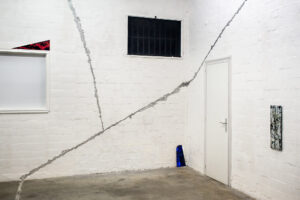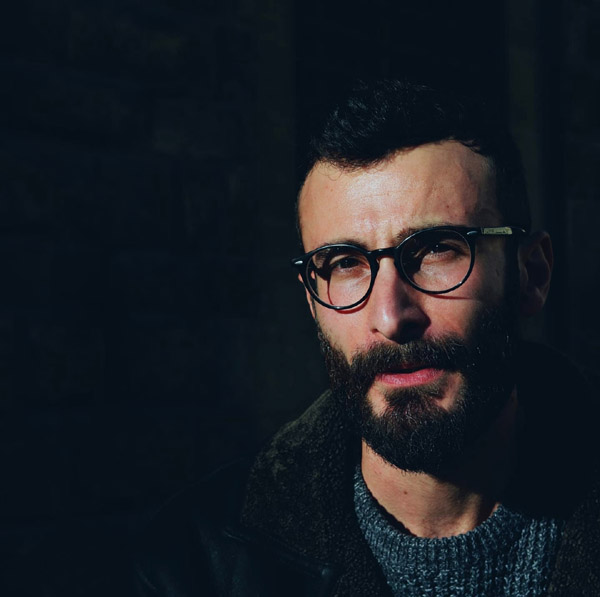Opened at the beginning of February 2021 in an industrial space in Rastignano (BO), adjacent to some artist studios, TIST – This Is So Temporary is a new project space in the local contemporary art scene, at least with regard to the intentions set by its founders, the artist and curator Yulia Tikhomirova (also among the founders of Nelumbo Open Project in Bologna) and the artist Michele Liparesi. The idea is not to conceive in a negative way the rapid flow of events that characterizes our time – the “liquid modernity” which Zygmunt Bauman referred to – but to try to bend this aspect to the needs of the present, to the urgencies that characterize the ‘today? (and perhaps also tomorrow) of contemporary art. All this is embodied into the fluidity of TIST’s nature, its ability to constantly change skin, and its ability to potentially reach every corner of our existence. Tikhomirova and Liparesi tell that in the following lines.
Antongiulio Vergine: From which reflections was TIST born?
Yulia Tikhomirova and Michele Liparesi: The idea of TIST was born as a reaction to the disorientation and discouragement we accused after a year of stop of artistic activities, which over time have become part of our identity. We had to react, go back to dealing with art not only on a theoretical and virtual level, as we had been doing for months: we needed to face a physical and empty space to start ‘filling’ it again. We decided to accept the temporariness (hence the name This Is So Temporary) of our daily life and the impossibility of planning the future, making it a strength and working with more freedom and flexibility, here and now. We transformed part of a shed, which functions as a laboratory for five artists, into an exhibition space, and we started setting up short 20-day ‘exhibitions’ of the artists we know, and those who have their studios nearby. These occasions immediately proved beneficial, both at the level of comparison on the work in progress and as a source of inspiration for new projects: so we opened TIST to ‘external’ proposals from other artists and curators. TIST has therefore become a project space in an industrial building where it is possible to try installation options which are different from the possibilities allowed by the more structured space of a gallery
TIST is by its nature itinerant – you proved it with Marameo, the last invited artist who performed interventions in the historic center of the city. Are you thinking of continuing with this double exhibition-urban interventions trend?
TIST’s starting idea lies in working on “temporary set-ups for transformable spaces”. Beyond the warehouse in Rastignano, where we mainly operate, TIST moves through the historic center and the suburbs, collaborating with other realities and / or intervening directly in the street, as for the Suture project by Marameo. We tried to respect and express his identity as a street artist, and therefore we implemented two parallel developments of his work, the indoor exhibition and urban signage in the city. But each artistic ‘case’ is different and temporary. Among the ideas that we are developing in this period, there is that of setting up a project inside the barn of an agricultural farmhouse, or that of “occupying” the rooms of a central gallery.
I believe that TIST is a totally new reality in the local art scene. Do you think this will encourage a new way of understanding art spaces?
It is difficult to anticipate now. We must first return, if not to pre-Covid normality, at least to the opening of the independent spaces of the city, heavily penalized by the management of the emergency even if only with respect to commercial galleries. TIST, on its own, has a particular identity, laboratory and peripheral – it is located in a renovated warehouse just outside Bologna, which for six years has hosted several artist studios. In addition to the workshops and the exhibition space, TIST has the common area and the garden. Nearby there are other warehouses used as studios by Bolognese artists. The thought that encourages us to carry on the project is to create a sort of district dedicated to artistic research outside the historic center: far from the concepts of ‘coworking’ or speculative redevelopment of spaces, we are rather interested in creating a shared and free artistic production.
Speaking of independent spaces, what consequences do you think can occur as a result of this complicated – and lasting – situation? Will it be possible to draw anything positive out of it?
The consequences of a year of closure are very serious: there are realities that have lost their spaces because they are no longer able to pay the rent. In our opinion, independent spaces must build a sort of cultural process parallel to the institutional one, jointly making demands common to politics, in order not to be neglected as happened during this period.
You started with the artists Uried Schmid-Téllez and Marameo. What will be the next? Can you tell us something about the next appointments?
We are planning a sculptural installation and a video art project (probably). We do not do long-term planning, as the project is by its nature temporary. This Is So Temporary.
Antongiulio Vergine
Info:
TIST – This Is So Temporary, via Vincenzo Bellini 1, Rastignano (BO)
tist.situation@gmail.com
@tist.situations
 Marameo, Suture, TIST – This Is So Temporary
Marameo, Suture, TIST – This Is So Temporary
 Marameo, Suture, TIST – This Is So Temporary
Marameo, Suture, TIST – This Is So Temporary
 Uriel Schmid-Téllez, Discrete Continuous, TIST – This Is So Temporary
Uriel Schmid-Téllez, Discrete Continuous, TIST – This Is So Temporary
 Uriel Schmid-Téllez, Discrete Continuous, TIST – This Is So Temporary
Uriel Schmid-Téllez, Discrete Continuous, TIST – This Is So Temporary
 RunMarameoRun, Marameo, Suture, This Is So Temporary
RunMarameoRun, Marameo, Suture, This Is So Temporary

Born in Campi Salentina (LE). After the three-year degree in Technologies for the Conservation and Restoration of Cultural Heritage at the University of Salento, I attend the Master of Science in Visual Arts at the University of Bologna. I collaborated with Galleria d’Arte Maggiore g.a.m. (Bologna) and with MUMA – Museum of the Ancient Sea in Nardò (LE). I am interested in events concerning contemporary art, in particular those related to video-photographic and performative practices. I write for ATPdiary and Juliet Art Magazine.






NO COMMENT